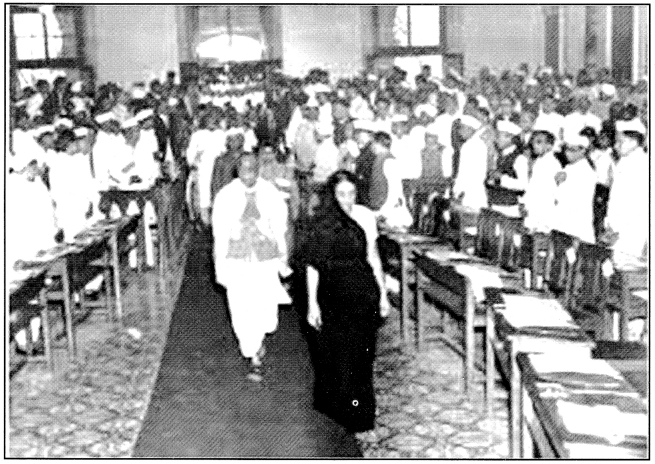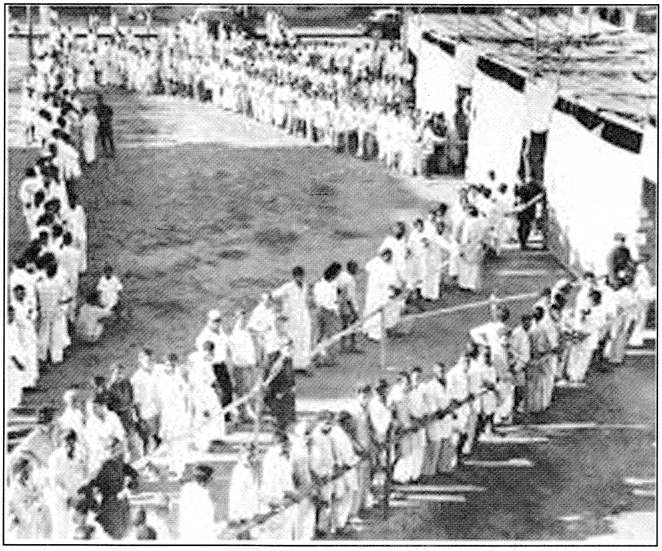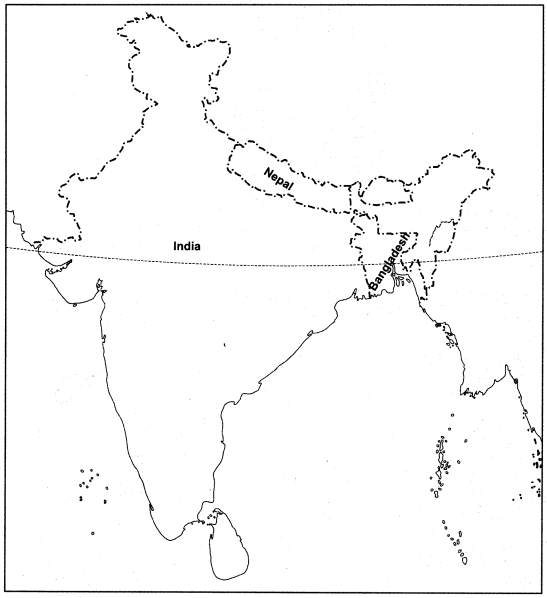If you’re looking for a way to enhance your Social Science, then look no further than the NCERT MCQ Questions for Class 8 Civics Chapter 1 The Indian Constitution with Answers Pdf free download. MCQ Questions for Class 8 Social Science with Answers is perfect for those who are in class 8 and want to get ahead of everyone else by mastering their subject skills as soon as possible! So, ace up your preparation with MCQ of Chapter 1 Civics Objective Questions.
The Indian Constitution Class 8 MCQs Questions with Answers
Solving MCQ on The Indian Constitution Class 8 with Answers can be of great help to students as they will be aware of all the concepts. These Class 8 SST Civics Chapter 1 MCQ with Answers pave for a quick revision, thereby helping you learn more about this subject.
Question 1.
Which part of the Indian Constitution has been referred to as the ‘Conscience’.
(a) Secularism
(b) D.P.S.P
(c) Fundamental Rights
(d) Fundamental Duties
Answer
Answer: (c) Fundamental Rights
Question 2.
Which is the 3rd tier of government?
(a) Panchayati Raj
(b) Municipal corporation
(c) State government
(d) Central government
Answer
Answer: (a) Panchayati Raj
Question 3.
When did Indian National Congress (INC) make the demand for a Constituent Assembly?
(a) 1934
(b) 1945
(c) 1946
(d) 1947
Answer
Answer: (a) 1934
Question 4.
When did the Maoists join other political parties in Nepal to sign a 12-point agreement?
(a) April 2006
(b) October 2007
(c) Nov, 2005
(d) Feb 2005
Answer
Answer: (c) Nov, 2005
Question 5.
The Constitution prohibits human trafficking, forced labour, and children working under 14 yrs of age. It is mentioned under which Fundament Right?
(a) Right to Freedom
(b) Right to Freedom of Religion
(c) Right to Constitutional Remedies
(d) Right against Exploitation
Answer
Answer: (d) Right against Exploitation
Question 6.
Which court issue the Writs?
(a) District Courts
(b) Panchayats
(c) Civil Courts/Criminal Courts
(d) Supreme Court/High Courts
Answer
Answer: (d) Supreme Court/High Courts
Writs can be issued by Supreme Court/High Courts. In common law, a writ is a formal written order issued by a body with administrative or judicial jurisdiction in modern usage, this body is generally a court.
Question 7.
Panchayati Raj is the tier of which government?
(a) First
(b) Second
(c) Third
(d) Fourth
Answer
Answer: (c) Third
In India, we have governments at the state level and at the center. Panchayati Raj is the third tier of government. It refers to the existence of more than one level of government in the country.
Question 8.
When did our Constitution was adopted and was enforced?
(a) 26 January, 1950
(b) 15 August, 1947
(c) 2 October, 1950
(d) 26 November, 1949
Answer
Answer: (a) 26 January, 1950
It was adopted by the Constituent Assembly on 26 November 1949, and came into effect on 26 January 1950. With its adoption, the Union of India became the modern and contemporary Republic of India replacing the Government of India Act, 1935 as the country’s fundamental governing document.
Question 9.
According to which set of fundamental rules the country functions?
(a) A law
(b) An amendment
(c) A constitution
(d) A preamble
Answer
Answer: (c) A constitution
A set of fundamental rules According to which the country functions is called a constitution. It helps serve as a set of rules and principles that all persons in a country can agree upon as the basis of its way.
Question 10.
By which amendment the Fundamental duties were included in the Constitution?
(a) 38th Amendment
(b) 42nd Amendment
(c) 40th Amendment
(d) 39th Amendment
Answer
Answer: (b) 42nd Amendment
The Fundamental duties were included in the Constitution in 1976 through the 42nd Amendment.
Question 11.
What are the objectives for implementing the fundamental rights according to Dr. B.R. Ambedkar?
(a) To ensure every citizen is benefited
(b) To ensure every citizen is rich
(c) To ensure every citizen has ration card
(d) None of these
Answer
Answer: (a) To ensure every citizen is benefited
Ambedkar stated that the object of the fundamental rights is to ensure, firstly that ‘every citizen must be in a position to claim those rights, secondly they must be binding on every authority.
Question 12.
What is the significance of the Preamble in the Indian Constitution?
(a) States the objectives of the president
(b) States the objectives of the election
(c) States the objectives of the Constitution
(d) None of these
Answer
Answer: (c) States the objectives of the Constitution
The Preamble of the Indian Constitution is significant so far as it states the objectives of the Constitution justice, liberty, equality and fraternity.
Question 13.
What is Sovereignty?
(a) Freedom to establish new country
(b) Freedom to govern oneself
(c) Peoples government
(d) None of these
Answer
Answer: (b) Freedom to govern oneself
Sovereignty means independence and freedom to govern oneself. Sovereignty is the full right and power of a governing body over itself, without any interference from outside sources or bodies.
Question 14.
What is Democracy?
(a) Rule of people
(b) Rule of king
(c) Rule of British
(d) None of these
Answer
Answer: (a) Rule of people
Democracy is a system of government referred as rule of people. The government of the people, by the people and for the people is called democracy.
Question 15.
What is a Constitution?
(a) Set of rules of court
(b) Set of rules to govern country.
(c) Set of rules of company
(d) None of these
Answer
Answer: (b) Set of rules to govern country
A constitution is a set of rules according to which the government of a country governs. The Constitution of India is the longest written constitution of any sovereign country in the world, containing 444 articles in 22 parts.
Question 16.
What type of government India practiced?
(a) Monarchy
(b) Democracy
(c) Anarchy
(d) None of these
Answer
Answer: (b) Democracy
India is a type of democracy. Democracy is a system of government referred as rule of people. The government of the people, by the people and for the people is called democracy.
Question 17.
What is the name of the Kingship or rule of a king?
(a) Democracy
(b) Constitution
(c) Monarchy
(d) None of these
Answer
Answer: (c) Monarchy
Kingship or rule of a king in absolute manner is called monarchy. A monarchy is a form of government in which a group embodies the country’s national identity and its head, the monarch, exercises the role of sovereignty.
Question 18.
What defines the introduction to our constitution?
(a) Preamble
(b) Sovereignty
(c) Constitution
(d) None of these
Answer
Answer: (a) Preamble
The introduction to our constitution is known as the preamble. Preamble to the Constitution of India is a brief introductory statement that sets out the guiding purpose and principles of the document.
Question 19.
What do you mean by Right to equality?
(a) Rich people are higher than poorer
(b) All are equal before law
(c) Government officer are superior
(d) None of these
Answer
Answer: (b) All are equal before law
All persons are equal before the law. It states that no citizen can be discriminated against on the basis of their religion, caste or sex
Question 20.
Buying and selling of human beings include in which right?
(a) Right to Equality
(b) Right to Freedom
(c) Right against Exploitation
(d) None of these
Answer
Answer: (c) Right against Exploitation
The practice of the illegal buying and selling of different commodities across national borders, it refers to illegal trade in human beings, particularly women and children.
Write true (T) or false (F)
1. In a monarchy, citizens choose their leaders so that they can exercise power with responsibility on the citizen’s behalf.
Answer
Answer: False
2. There are three organs of the state according to the Indian Constitution.
Answer
Answer: True
3. It is not necessary that all countries that have Constitution are democratic.
Answer
Answer: True
4. In 2007, Nepal adopted an interim Constitution.
Answer
Answer: True
5. Mahatma Gandhi was known as the father of the Indian Constitution.
Answer
Answer: False
Match the following
1.
| Column-I | Column-II |
| 1. Gurantees the rights of individuals against the state | (a) Panchayati Raj |
| 2. Father of the Indian Constitution | (b) Federalism |
| 3. 3rd tier of the government | (c) Fundamental Rights |
| 4. Existence of more than one level of government | (d) Dr. B.R. Ambedkar |
| 5. The cruel and unjust use of power and authority | (e) Tyranny |
Answer
Answer:
| Column-I | Column-II |
| 1. Gurantees the rights of individuals against the state | (c) Fundamental Rights |
| 2. Father of the Indian Constitution | (d) Dr. B.R. Ambedkar |
| 3. 3rd tier of the government | (a) Panchayati Raj |
| 4. Existence of more than one level of government | (b) Federalism |
| 5. The cruel and unjust use of power and authority | (e) Tyranny |
Fill in the blanks
1. Baba Saheb Ambedkar is known as the ……………………… of the Indian Constitution.
Answer
Answer: Father
2. In ……………………… societies, Constitution often lays down rules that guard against the misuse of authority by our political leaders.
Answer
Answer: Democratic
3. Between December ……………………… and November ……………………… the Constituent Assembly drafted a Constitution for independent India.
Answer
Answer: 1946, 1949.
4. ……………………… is responsible for administering and enforcing laws.
Answer
Answer: Government
5. ……………………… refers to the existence of more than one level of government in the country.
Answer
Answer: Federalism
Picture Based Questions
1.

1. What type of relation is in the figure signified amongst the member of the constituent assembly?
2. About whom does the above picture shows?
Answer
Answer:
1. There is shown an extraordinary sense of unity amongst the members of the constituent assembly.
2. It shows Sardar Vallabhbhai Patel, a prominent member of constituent assembly.
2.

1. Whom does the picture refers to?
2. What was the believe of Dr. Ambedkar about the scheduled castes?
Answer
Answer:
1. Baba Sahab Dr. Ambedkar is shown as the Father of Indian Constitution.
2. Dr. Ambedkar believed that his participation in the constituent assembly helped the scheduled castes get some safeguards in the draft constitution.
3.

1. What does the picture shows?
Answer
Answer:
1. This shows about people standing in line to cast their votes.
Map Skills
1.
Mark the following in such a way by colouring them with your desired colour so that we all could easily differentiate their boundaries.
(i) India (ii) Nepal (iii) Bangladesh
Answer
Answer: 
Hope you found this information on NCERT MCQ Questions for Class 8 Civics Chapter 1 The Indian Constitution with Answers Pdf free download useful. We are always here to help, so if there is any specific query or question with CBSE Social Science The Indian Constitution Class 8 MCQs Multiple Choice Questions with Answers or any other topic please let us know in the comments below.